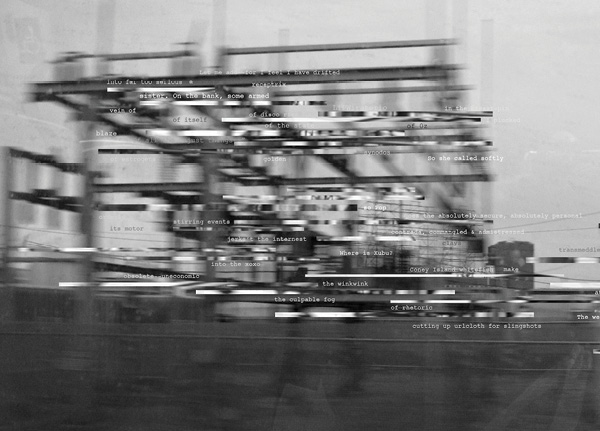
EXIT 43/USCITA 43
first performed on
May 14, 2011
Corto Circuito, Rome, Italy
performed 0 times in 2011
JENNIFER SCAPPETTONE & THE DIFFORME ENSEMBLE
Marco Ariano, Roberto Fega, Renato Ciunfrini
Chicago, IL / Rome, Italy
299367300j299367300s299367300c299367300a299367300p299367300e29936730072993673007299367300@299367300g299367300m299367300a299367300i299367300l299367300.299367300c299367300o299367300m
oikost.com,
marcoariano.idra.it
EXIT 43/USCITA 43
JENNIFER SCAPPETTONE & THE DIFFORME ENSEMBLE
“Exit 43” is an archaeology of toxic landscapes and opera of pop-up pastorals in progress across various media since 2006. Pop-up windows striated with shredded documentary stills of dystopian landscapes and idylls gone awry embed Greeklike choruses at odds. The work samples the syntax and nonsense logics of Lewis Carroll’s underground to combine the voices of virtualized CEOs, schoolmasters, toxins, EPA Superfund statistics, Victorian poetasters pursuing the undead organic, and an Alice dodging malice in search of knowledge in underland. The poetic scores can be read in silence or performed in beguilingly lyric strains of discordance, occasionally becoming caught up in vertiginous motion at points of spatiorhetorical ambiguity. These poetic landscapes, through which text courses virally and multidirectionally, reproduce the labyrinthine effort of conducting research into sites of corporeal harm that are incompletely virtual. Rechanneling them through the body itself is the work’s ultimate aim.
After performances in 2008-10 in New York at the Prosodic Body with Robert Kocik, Daria Faïn, Stefani Barber, and others, and solo at Belladonna, at Red Rover in Chicago with Judd Morrissey, Mark Jeffery, and Lori Talley, and at Naropa University with Akilah Oliver and Daniel Staniforth, which featured choral renderings of projected texts, Jennifer Scappettone met musician/composer/poet/artist Marco Ariano in Rome, Italy. They decided to collaborate on constructing “Exit 43” as a sonic environment with Ariano’s Difforme Ensemble, including Roberto Fega on objects and electronics, Renato Ciunfrini on bass clarinet and electronics, and the voices of architect Ersela Kripa and filmmaker Karen Yasinsky. Against the backdrop of the oil spill in the Gulf of Mexico, the earthquake, tsunami, and nuclear disaster in Fukushima, and the perpetual garbage crisis sustained by the ecomafia carpeting the streets of Naples, Ariano and Scappettone decided that bringing the public, operatic aim of the work to fruition at a centro sociale in a popular quarter of Rome (Cinecittà) would be a risk worth taking. Scappettone translated the work into Italian for bilingual performances at Corto Circuito in Cinecittà and at the Casa Rustica of the American Academy in Rome in May and July 2011.
Over the course of performance, echoes of obsolescing machines, apocalyptic little girls, sumpdiggers, errant buckets, and undifferentiated murmurers made up the grey noise against which the pop-up opera articulated itself in hypodiscursive song and on the wall. Rehearsal and performance recordings, each a stray outtake into a liquidating enormity of disaster, were spliced into a sound poem about the imperial orchestration and contamination of waters called “X Locus (Abluvion),” installed in Trajan’s Aqueduct below the cryptoporticus of the American Academy in Rome in May 2011.